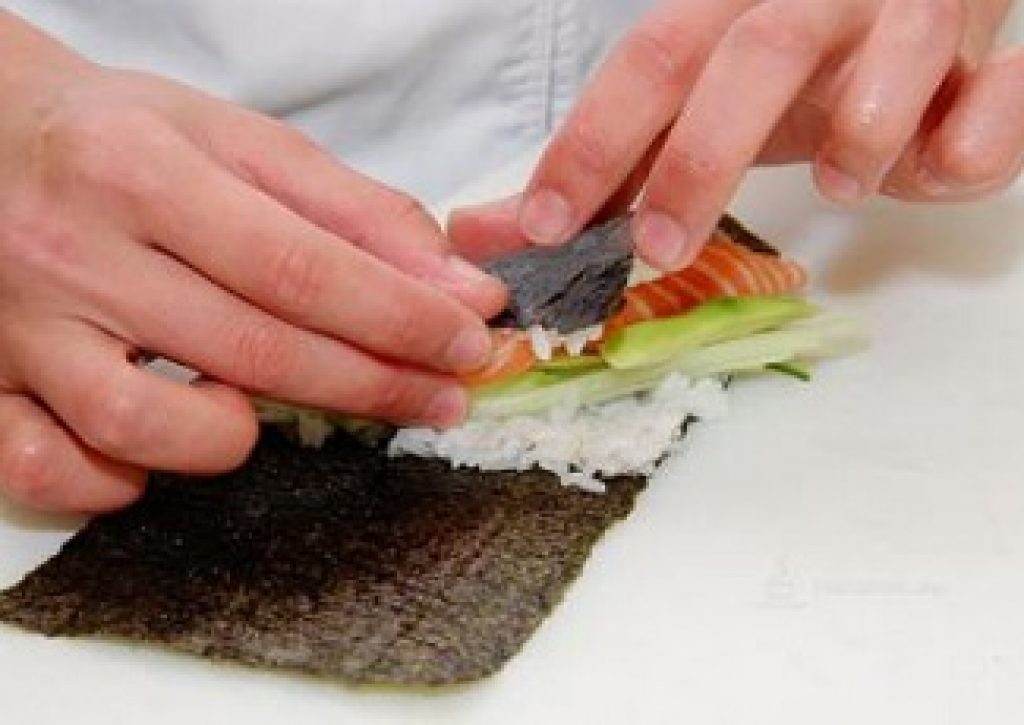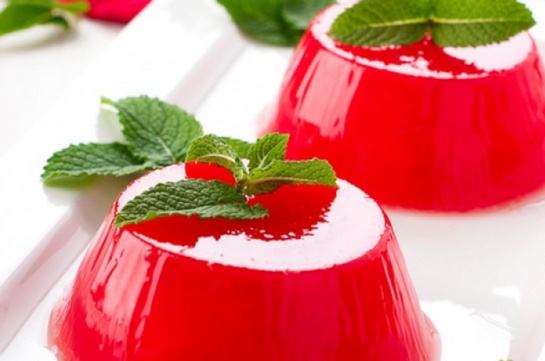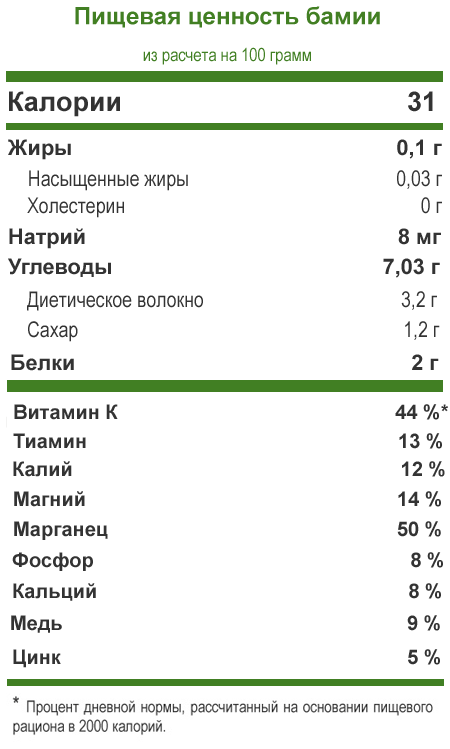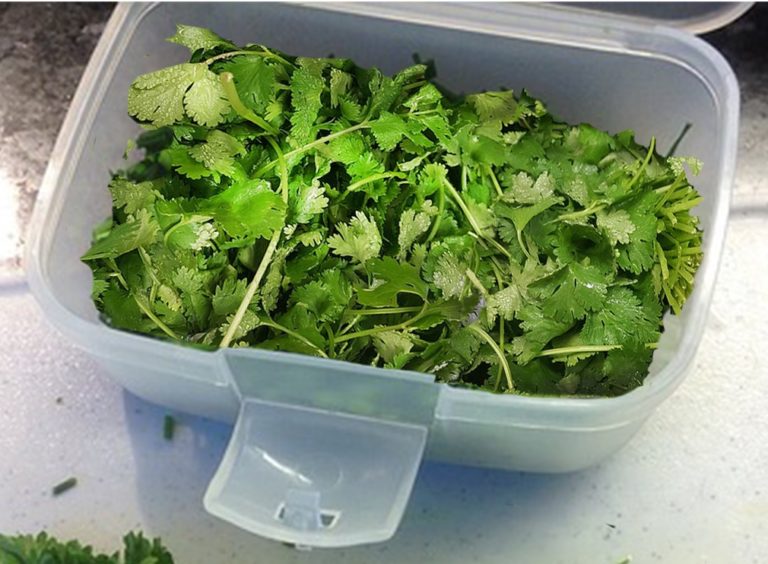How much to sterilize a 3 liter can for a couple. How to sterilize jars - a quick and proven way
When it comes time to close homemade pickles, jams, you must follow all the rules of the procedure. Most recipes are designed for banks to be sterilized before closing. This process can be carried out in several ways. The vessel is placed in a microwave, electric or gas oven, sometimes it is done in a pan.
How to sterilize empty cans
For good conservation jam or other preparations you need to properly prepare the container. As a rule, empty cans are sterilized, but some recipes already include this process with the ingredients.
It is important to immediately prepare a suitable container that will not burst. Sterilizing cans in the oven requires compliance with the following rules:
- The first task is to carefully inspect the containers. If cracks, chips on the neck are found, such a container can be safely sent to the bin. Any flaws that can violate the tightness of the vessel will lead to the fact that the container will burst or simply deteriorate, will leak during cooking.
- Fill all dishes with water and leave them to stand for 3 hours. All dirt, dried particles, microorganisms and bacteria will lag behind the walls, it will be much easier to remove them during washing.
- Best preparation tool glass jars considered soda. It will help to clean the surface of any stains, dirt and will not leave a specific smell, which will then be present in pickles or jam. When processing containers, it is recommended to use a new sponge, on which there are no residues of other food, germs. Wash the bottom thoroughly.
Cans for canning
Sterilization in an electric oven
Some people did not buy gas ovens, but electric ones. They are also suitable for sterilization. The procedure is not much different, so no difficulties should arise. Sterilization in the oven, electric rather than gas, is carried out according to the following instructions:
- The oven must be clean so that old odors are not absorbed.
- You can place empty, dry or wet cans in the oven. In the first case, they should be set with their neck down, in the second - up, so that excess moisture evaporates.
- If desired, you can simultaneously place iron lids on the baking sheet (not nylon).
- After that, turn on the device, set the mode to 150 degrees Celsius. This temperature is enough to destroy all harmful microorganisms.
- When the required temperature is reached, it is necessary to hold the jars for a certain time (the duration will be described in the sections below).
- Warm containers should be removed very carefully. It will be hot, so it can burn your hands. Only dry, clean potholders or gloves should be used, because wet ones will create a temperature difference and the container will burst. Better let it cool for a few minutes. Do not take the vessel by the neck; it may break off.
This type of device is very common, so this method of sterilizing cans in the oven is considered the most popular in the CIS countries. This preparation option is the simplest, most reliable, it allows you to prepare many containers for home cooking at one time. Instructions on how to sterilize jars in a gas stove oven:
- After washing, the cans are placed downside down in a still cold oven. In order for the liquid to evaporate faster, the container should be placed correctly (with the neck up), but then there is a possibility, then a white coating will form on the bottom due to the high hardness of the water. It will not spoil your dish, it will not harm your health, but it will not look aesthetically pleasing. You can fulfill this condition at your discretion.
- When placing the container on a baking sheet, make sure that it does not touch. When heated, the jars can crack if placed tightly to each other, which will make them unsuitable for cooking.
- You can put the same covers here (only iron).
- No need to bring the temperature to maximum. First turn on the mode so that the air inside is warm, and then translate into a state of up to 180 degrees.
- Some housewives determine the readiness of containers on the appliance door. First, it fogs up, and then it becomes dry again. After this, the container should be removed.
- First turn off the oven, open the door, let the banks cool. They are very hot, so getting out with your bare hands is strictly not recommended. Use a clean, dry towel or gloves.
Sterilizing cans in the oven

How to sterilize jars with blanks
Most winter baking recipes require sterilizing cans in the oven along with the ingredients. To fulfill this condition is easy in the oven, it is done quickly. Instructions on how to properly sterilize jars with blanks:
- Place containers with ingredients without lids in a cold oven.
- Turn on the mode at 100 degrees.
- Leave to be sterilized for 20 minutes (the time may be different depending on the volume of the container).
- Take the tack hot jar, carefully remove it (make sure that it does not slip out of your hands due to moisture formed). Take only on the sides: if you grab the neck, it can break off.
- Then roll up the preservation lid.
Oven jars
How much to sterilize cans in the oven
Whichever processing method you choose, it is important to know how much to sterilize the cans. If you hold it a little, it is likely that some microorganisms will survive, and with prolonged sterilization, the cans left in the oven may burst. The duration of the procedure depends on the volume, the estimated processing time is as follows:
- up to 1 liter - 10 minutes;
- 1 liter - 15 minutes;
- 2 liters - at least 20 minutes;
- 3 liters or more - 30 minutes.
Summer and the beginning of autumn delight us not only with warm weather, but also with actively ripening fruits, berries and vegetables. For housewives, the hottest time comes during this period, because all these generous gifts of nature must be preserved until the upcoming winter colds. Of course, many fruits can be dried and dried, but the most tasty preparationsmade at home are canned pickles, jams, jams and stewed fruit. However, so that all these stocks "survived" to frost and did not deteriorate, it is important not only to strictly follow the recipe, but also to be able to properly prepare the ingredients and the necessary containers.
How to prepare for rolling up products
Immediately before preservation, vegetables, berries, fruits and greens should be sorted and washed thoroughly under cold water. If the earth is stuck on the fruit, it does not hurt to use a soft brush or a thick sponge to remove soil from the skin. Pure ingredients are recommended to be put in a colander so that the glass excess waterand then dry well on a kitchen towel.
Sterilization of cans: preparatory process
Empty cans designed for winter blanks, must not have cracks, chips, chippings or other tangible defects. Lids should be selected at least carefully. Buy only high-quality tinplate products equipped with a protective lacquer layer that prevents metal from contacting the products. In this case, the lid does not oxidize and the taste properties of the seals do not change.
Important: If you use screw caps, you need to carefully monitor that there are no scratches or dents on the painted surface. Any imperfections on the coating during storage can cause metal corrosion, and this can lead to damage to canned products.
When the cans and lids are selected, they must be sterilized to remove all microorganisms from the surface. After that, the rolled-up products can be stored in them for a long time.
How to sterilize cans for preservation: general rules
Before sterilization, empty cans must be thoroughly washed. This item is mandatory even if the dishes seem to be very clean.
Tip: You should not take traditional detergents for processing, as they are highly concentrated and poorly rinsed. Better to use traditional baking soda. With it, you remove even the smallest dust invisible to the human eye from a glass surface. If the container is too dirty, then first you need to wash it with a simple kitchen soap and only then treat it with soda.
Lids should also be prepared. It is very important that they are free from rust and any damage. Rubber gaskets should be completely new without a hint of cracking. Otherwise, the tightness of the seaming is not guaranteed.
Sterilization is carried out in several ways: on steam, in boiling water, in the oven or in the microwave. Each of them has its positive aspects and you can choose the option that is most convenient for you personally.
Steam sterilizing the jar has long been accepted. This method is considered both the oldest and the most common. This requires a medium-sized pot and teapot. There you need to pour clean water and send the container to the stove. Above it is necessary to place the grill from the oven or a metal sieve, and put the container requiring cleaning on it upside down. Boiling water will pour steam over the glass surface and destroy all germs within 15-17 minutes.
Processed cans without turning, then put on a clean towel. The method guarantees 100% quality and does not require unnecessary costs. Of the minuses, the housewives note too much moisture and heat output and some laboriousness of the process.
For sterilization in boiling water you will need a large pot. At the bottom it is necessary to put a wooden plank or a dense cloth, place the container on top and pour cool water so that they are completely covered. It is important that the jars do not touch during processing. Water should be warmed well over medium heat and boiled for 15 minutes. Cans immediately get out of the pan, not allowing them to cool.
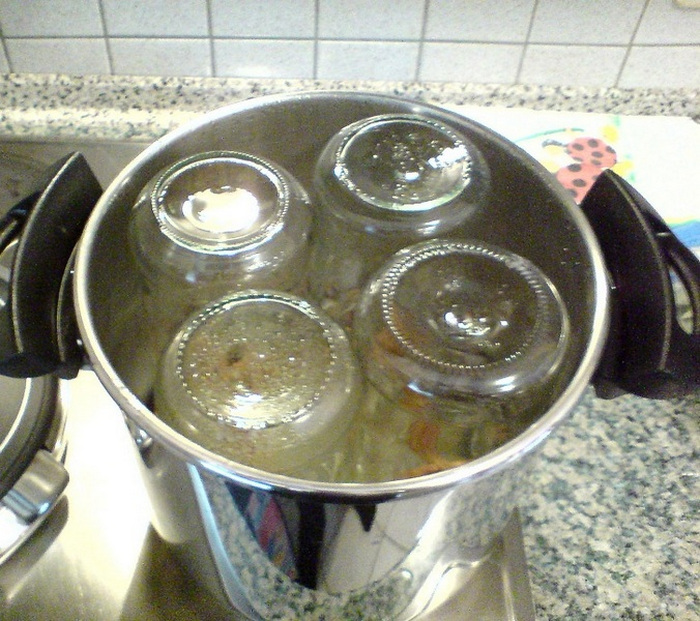
For processing, wash the container and, without wiping, send it to the oven. Set the temperature to 160 ° C and wait until the cans are completely dry. How much to sterilize capacity in this case, there are no clear instructions. You will have to monitor the process in real time, and as soon as the cans are dry, remove them from the oven and put them down on a clean kitchen towel.

Many people wonder if the jars are sterilized in the microwave. We will answer: "Yes, they sterilize." To do this, pour about 1 centimeter of water at the bottom of the bottles, put them in the microwave and process for about 2-3 minutes at a power level of 800 watts. The liquid will boil and the resulting vapor will destroy all bacteria that have settled on the glass.

How long does it take to sterilize cans
How many minutes to sterilize a jar depends on its volume. A half-liter container is usually processed for about 15 minutes, liter jar - 15-20 minutes, "kopeck piece" - 20 minutes, and 3 liter - about 25 minutes.
To sterilize cans with blanks, a wide pan is required, in which several containers can easily fit. It must be filled with liquid, lined with a cloth or towel and put on fire. When the water boils, lower the cans with special tongs. It is very important that the water level does not reach the neck of the sterilized cans by about 2 centimeters.

Typically, recipes always indicate exactly how much to sterilize products, but if this information is not available, then there are general parameters. Jars with vegetable salad, like cans with cucumbers and tomatoes, are usually processed for 15 to 20 minutes. This time is enough to destroy all bacteria and germs.
How to sterilize cans for preservation: video instruction
Not only depend on how correctly the procedure for rolling food for the winter will be carried out at home taste qualities dishes, but also their safety. That is why young housewives need to know how to sterilize cans in the microwave, oven or with the help of improvised means. We must not forget about the covers, otherwise mold quickly forms under them. The organization of the conditions necessary for sterilizing dishes should be taken care of before the time comes to work on the blanks. Otherwise, tomatoes, jam or cucumbers will wait in the wings, forcing them to rush into the processing process. And in a hurry, it’s better not to do such serious things.

Sterilize Empty Cans
Before sterilizing banks at home, it is necessary to carry out their preparatory processing. For this product, you need to thoroughly wash it with water with the addition of a small amount of soda. It is better to refuse standard washing and disinfecting compounds, they are able to settle on the walls and enter the body with food. Soda is easily washed off and does not harm even children. This stage is mandatory, even if the containers for the blanks for the winter were specially purchased at the store and wrapped with a protective film, and it is planned to use the most effective methods for their sterilization.
- Steam treatment. A suitable grid is installed on the pan with water (you can take a protective screen for deep-frying). We put the design on the stove, immediately install one or more cans upside down. We make sure that nothing prevents the pair from getting inside the tank. We turn on the stove, wait until the water boils and begins to produce steam. First, wait for the formation of steam, and then put out the banks is not quite right, so you can get a burn. How long it takes to sterilize depends on the volume of the can. A 3 liter container will take at least 25 minutes, 20 minutes is enough for 2 liters, and a quarter of an hour is enough for 1 liter.

- Using a microwave. Before sterilizing the cans in the microwave, you need to remember once and for all that in this way you can not process the lids as well. AT best case cans with blanks will quickly open, at worst - a household appliance will become worthless even in the process of work. The manipulation itself resembles the usual processing of containers with steam. To conduct it, you need to pour 2-3 cm of water into the container to be sterilized. We put the product or lay it on its side. We start the device, the timer of which is set for 5 minutes.

Tip: There is another steam sterilization method that can be used when a small number of cans are urgently sterilized to fill in blanks. The container is not installed on a massive pan, but on a teapot without a lid. The main thing is to reduce the heating intensity in time so that all the water does not boil away.
- Boil in the pan. AT large pot put out several cans, fill them with water. Next, we pour the liquid also into the container itself (it is good if the jars will stand up to the neck in water). We put the whole structure on fire and bring the liquid to a boil. The exposure time is the same as with standard steam treatment.

- Processing in the oven. Inexperienced housewives should first of all learn the method of sterilizing cans in the oven. It is simple and affordable, like other methods, but this way you can handle not only significant volumes of containers, but also metal lids. After washing the items slightly exposed, put them on the grate upside down in a still cold or slightly warm oven. We close the appliance door, heat the chamber to 150 ° C and hold as much as with other approaches related to steam treatment.

- Sterilization by vinegar. The method of sterilizing 0.5 l of dishes with vinegar has a clear advantage - the processing is not thermal, but chemical, so you do not need to boil anything. Just fill the jar on the shoulders with water, add 6 tablespoons of 70% vinegar, cover the container with a plastic lid. We shake it for 10 seconds, after which we pour water with vinegar into a new jar and carry out the same manipulation. We place the processed containers upside down on a towel, after which you can put jam, cucumbers, salads and any other dishes in them. Just one serving acetic solution on water we use for all cans.

Today in hardware stores they sell a lot of devices that can significantly simplify the sterilization process at home, conduct it correctly, quickly and safely. It can be nozzles, containers made of heat-resistant glass, tongs, initially sterile caps.
How to sterilize jars with blanks?
If you need to process tomatoes or cucumbers already rolled up for the winter, as some recipes require, you can use at least two approaches:
- How to sterilize jars in the oven, if they are already filled with blanks and marinade. We put ready-made cans on a wire rack or a baking sheet, put metal lids on top (nothing needs to be twisted). We close the door, bring the temperature in the chamber to 120ºС. In this case, twist for the winter you need to keep as much as indicated in the recipe. If there are no specific numbers, we adhere to the standard indicators for the oven.

- Processing in boiling water. We cover the pan with a thin towel, fill it with jars of blanks, fill it with water. The temperature of the liquids outside and inside the jars should be the same, otherwise the glass may burst. We bring the water level to the "shoulders" of the cans. Spread the lids on top, but do not fasten. We bring the contents of the pan to a boil and only after that we note the time indicated in the recipe. As a last resort, we adhere to standard recommendations.

It is worth considering that in additional sterilization need cucumbers, tomatoes, various salads. Dishes such as preserves do not need to be processed. They are simply laid out in sterile jars and rolled up.
Features of cap sterilization
If metal covers when using the oven can be sterilized simultaneously with banks (from 15 to 30 minutes at a temperature of 150 ° C), plastic ones in any case will have to be processed separately.
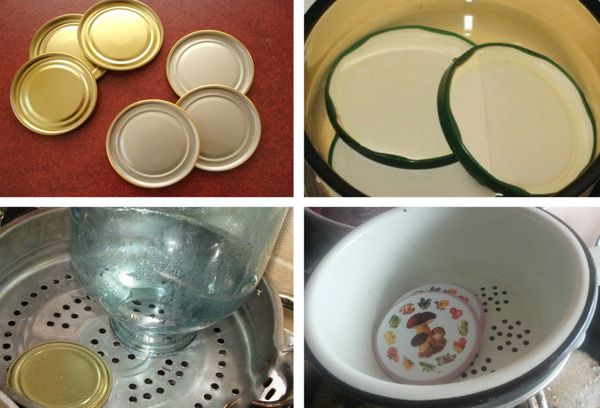
Most often they are simply laid out in a pan with water, the liquid is brought to a boil and after that they are spotted for at least 10 minutes. If the products are underexposed, then the cans with blanks will be swollen or opened for the winter. There is another important point - it is better to get accessories from boiling water with special sterile forceps or tweezers. So objects will not burn your hands and will not get dirty before use.
Some housewives prefer physical sterilization methods, while others prefer physical. Practice shows that all of them are equally effective if the manipulations are carried out correctly.
Before proceeding with the preparation of various pickles and jams, any housewife must first properly sterilize the jars.
The sterilization process is simple, although it takes an additional five to seven minutes. However, despite the time spent, you protect yourself from problems with clouding or souring of cans in the future during storage.
So, how to sterilize cans at home? Consider the most common and convenient ways.
Training
Wash cans with soap and water to wipe off dirt and dust from the inside. Sterilization will not clean the cans of dirt!
Steam sterilization of cans.
It also distinguishes several variations of this method.
Option 1
For this method, we need a special circle for can sterilization, which is sold in all tableware and hardware stores and costs from 15 to 50 rubles (see photo). There are circles for one can, and there are for three cans.

We turn the jar and put the neck down on the circle (as in the photo). And this circle, in turn, is put on a pan in which water boils.
We also throw metal lids into the pan into the water, with which we will further tighten the cans (as in the photo).
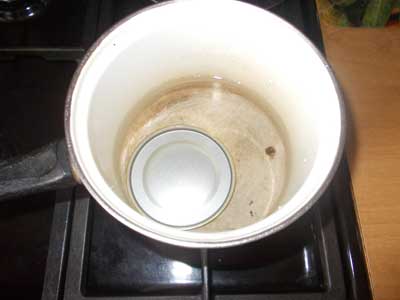
How much to sterilize banks in a similar way? Five to seven minutes and turn off the fire. We take the jar with a towel or mittens on the side walls, turn it over and put it on the bottom on a prepared towel, on which in the future it will stand until we twist it.
We pull out the lids from the pan with metal tweezers. If this is not (although every woman has one), we pull it out with two forks and put the lid upside down so as not to contaminate the part with which we will twist the jar.

Option 2
We turn the jar and "dress" on the spout of the teapot. For these purposes, you must have a teapot with a long nose, so that the can on it is kept well enough. And so that the nozzle was without a whistle, otherwise steam will not come out through the closed nozzle and the bank will not be sterilized. We also throw metal lids into the kettle and boil.
Option 3
Looks like the first option. We turn the jar over and put it in a small bucket in which water boils. A circle is not needed, since the can is standing on the bucket with its neck. By the way, in this photo I sterilize a jar on an induction cooker in a similar way. Very convenient option.

Steam sterilization of cans does not kill all microbes, since the temperature of the steam is only 100 degrees. But those microbes that can cause souring of pickles are completely killed at this temperature. Therefore, boldly use this method without fear of anything.
How to sterilize cans in the oven (dry method)
This method is also quite simple. But it requires certain precautions.
We put clean and dry cans in the oven, turn on the fire to the maximum and sterilize at maximum temperature. Next we put metal covers on the grill.
How much to sterilize banks in this way? 10 minutes at maximum temperature.
Then open the oven and let our banks cool.
Attention:
In this method, the cans are heated to temperatures above 250 degrees. Therefore, they can crack if they are put in the oven moist, or if they are immediately removed from the oven. Be sure to let the banks cool for five minutes. And take them with a dry towel or mittens so that they do not crack from the temperature difference.

How to sterilize cans in the microwave
This is another way to quickly sterilize cans at home.
Just place a clean jar in the oven and turn the microwave on to maximum.
Sterilization time is five minutes.
Attention.
There is one “but”! On the contrary, in this case, pour a little water on the bottom of the can. What for? The fact is that the waves from the microwave heat exactly water, not air. The water in the jar begins to boil, and the jar walls are sterilized with steam. If you put a dry jar, it will not be sterilized in the microwave.
And further. Metal covers cannot be sterilized in this way, so as not to spoil the microwave. Have to boil them again.
Oven and microwave sterilization
The method of sterilizing cans in the oven is good in that you can process several cans at once, not spending so much implication on the sterilization process.
First of all, the jars must be washed well, and then put in a cold or preheated oven, on the wire rack. If the jars are dry, place them with the neck down, and wet ones up, so that the water has time to evaporate. At a temperature of 150 ° C, 15 minutes will be enough.
For filled cans, the sterilization method in the oven is also suitable. Heat the oven to 100 ° C, place the filled cans on the wire rack, but do not cover with lids. Note the time - for cans with a volume of 0.5 l, it will take 10 minutes, and for liter - 15 minutes. Remove the cans from the oven and immediately roll them up. Turn the rolled cans upside down so that they are completely cool.
The method of sterilizing cans in microwave oven takes even less time. However, there are subtleties. Do not put empty cans or metal objects in the microwave. Therefore, only jars can be sterilized in the microwave, without lids. And so that the cans do not burst, place a glass of water on a rotating stand. Or, as an option, pour some water (approximately 50-70 ml) into the cans themselves. In this case, sterilization will take 2-3 minutes, at full capacity.
Sterilization in boiling water
You will need some important items. Firstly, one large, heavy pan, 15-20 liters. The main thing is that it should be wide, and 3-4 or better 5 cans fit in it. By the way, both banks and lids can be sterilized at the same time, on two burners. To sterilize the lids, a small pan or heavy saucepan is suitable. And it is most convenient to get them with forceps with wide blades.
Prepare some clean “waffle” towels, paper napkins, and a roll-up machine in advance. Set aside the required number of tin covers with rubber rings. Take with a margin so that, if necessary, extra covers are at hand.
First you need to wash the jars well: soak them in warm water with the addition of soda, it’s better for a couple of hours. Then wash with a detergent brush, rinse with cold water and dry. Then put the empty cans upside down in a pan filled warm water about a third. If there are several cans, put a wire rack on the bottom of the pan so that the cans do not beat against each other. Bring the water to a boil and sterilize the jars for 5 minutes. Take it out by wrapping it in a triple folded lengthwise towel and set it to dry on paper towels.
Prepare the covers. Wash tin covers and rubber rings in warm water with detergent. Rinse and dry, then insert rings into each cap. Walk around the edge to press firmly. After that, lower the caps into boiling water. Sterilize for 5-7 minutes, then remove the covers with forceps, transfer to a waffle towel and allow to dry.
Next, fill the jars with some blank, with the help of the machine roll them up with tin lids. The cover should be rolled tightly, but should not turn. Flip over closed jar upside down and place on a towel - until completely cooled.

If you sterilize food-filled cans, then pour into a pan cold water, heat it to about 30 ° C. Place cans filled with blanks in the pan. Water should cover the cans in half, and preferably ¾ of the volume.
If banks close glass lids with a metal shutter, they are sterilized closed. If the lid is tin, then the cans are sterilized open, and closed after sterilization. If there are several cans, put a wire rack on the bottom of the pan so that the cans do not knock or burst in the process.
Bring the water to a boil, and then reduce the heat to a minimum: during sterilization, the water should barely boil. Sterilization time will depend on volume, workpiece consistency and acidity. finished product. The more acidic and thinner, the less time is required for sterilization and vice versa.
Small jars, up to 0.5 l, are sterilized from 5 to 15 minutes. Liter cans - from 15 to 30 minutes, two-liter cans - from 20 to 40 minutes, and three-liter cans - from 30 to 50 minutes.
When right time will pass, remove the jars from the pan. Rearrange on a towel and roll up, corking with tin lids. Make sure that the cover is rolled tightly and does not turn. Turn the closed jar upside down and place on towels until it cools completely.




